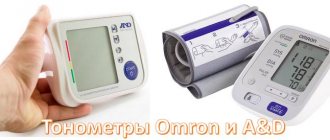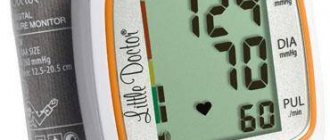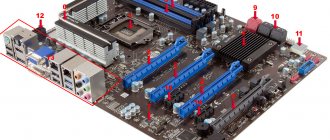High or low blood pressure is a fairly common problem. Most people, especially the elderly, need constant monitoring of blood pressure and heart rate. This is what tonometers are designed for, which can be used without problems at home. It is important to understand that blood pressure monitoring allows timely detection of serious diseases or their consequences. In addition, the doctor can get a more complete picture of the disease based on the tonometer readings.
The modern market provides a huge variety of different tonometer models for use at home. In general, tonometers can be divided into 2 types: mechanical and automatic.
Both the first and second are equally popular and in demand among the population. Automatic devices are more modern and are becoming more and more in demand every day. Mechanical blood pressure monitors are found in almost every home and medical facility.
Purpose of the device
Normal blood pressure in a healthy person is 120/80 mmHg. Art. Some people are characterized by lower or higher parameters, which is also a variant of the norm. However, a strong deviation from the indicated values indicates the development of dangerous diseases. To identify these disorders, it is worth using a special device - a tonometer.
This device should definitely be in the home medicine cabinet for people who suffer from hypertension. To prevent the development of a hypertensive crisis, such people should constantly monitor their blood pressure. Based on its results, the doctor selects adequate treatment.
The need to use a blood pressure monitor is not always associated with hypertension. After 50 years of age, blood pressure often increases due to poor general health. In such a situation, it is also necessary to measure blood pressure in order to provide timely assistance to the person.
Athletes often need a device to monitor their level of physical activity (modern devices allow you to measure not only blood pressure, but also pulse). In addition, the need for a tonometer is experienced by people who often face stressful situations or constant psycho-emotional stress.
People who have diabetes and hypotension should monitor their blood pressure parameters. It is also necessary to monitor such indicators during the period of bearing a child.
Important: If a person often experiences headaches, nausea, dizziness, or pain in the heart, this indicates a deviation of blood pressure readings from the norm, which is fraught with dangerous consequences.
The use of a tonometer allows you to identify disturbances in the functioning of the body. A timely call for an ambulance can save a person’s life.
How does posture affect blood pressure readings and which one should you take?
To accurately determine blood pressure, you need to achieve maximum muscle relaxation. Therefore, it is recommended to sit on a chair or chair with a backrest for several minutes before taking measurements. In this case, you cannot cross or cross your legs over one another, as this may result in the arteries being compressed. And this will already lead to a change in indicators.
The hands should not be in a hanging position; they should be placed on the table so that they are parallel to the heart. You should also avoid squeezing with clothing. It is recommended to sit in this position for ten minutes before the procedure, without talking to anyone, without watching TV or making active movements. Otherwise, the indicators may not be true. It is not prohibited to measure blood pressure in a supine position, but all of the above rules must be followed.
Correct body position when measuring blood pressure
For the accuracy of the indicators, you need to find out on which hand the test should take place. To determine this, you need to measure the pressure on both hands about ten times with intervals of two to three minutes. After the indicators from the left and right hands are recorded in two columns, analysis is performed. The pressure should be measured on the arm on which the result is higher.
Differing indicators on both hands are not considered a deviation, and this is due to the anatomical feature of the functioning of the heart muscle. If the result is the same or differs, but only slightly, then the test should be carried out on the right hand, and for left-handed people - on the left.
The tonometer cuff should be located on the bare part of the arm, two centimeters above the elbow. If it is located above the heart, the measurement result will be underestimated, and if lower, it will be overestimated.
Inaccuracy can be decisive, since if you move a couple of centimeters in either direction from the level of the heart muscle, you can get readings two millimeters of mercury more or less. In this case, the cuff must be tightened evenly so that it covers the entire arm and is secured with Velcro. The needle on the pressure gauge must be at the zero position before starting the procedure.
Correct cuff position
Types of tonometers
The classification of such devices is based on the principle of operation. There are mechanical, automatic and semi-automatic devices. They are also classified according to the area of measurement. Based on this criterion, wrist and shoulder devices are distinguished. The latter are used more often due to the high accuracy of measurements.
Note: There are also devices for monitoring blood pressure on the finger, but their accuracy is not so high.
Mechanical tonometer
Many people are interested in what this type of blood pressure monitor consists of. The device includes elements such as a cuff, a phonendoscope, a bulb and a pressure gauge. The last element can be mercury or membrane. Mercury is considered more accurate.
In some models, the stethoscope is connected to a cuff. A mechanical tonometer has the most affordable price, but its use requires certain skills and good hearing. Sometimes people cannot take measurements correctly with such a device. The accuracy of the obtained values directly depends on the person’s skills.
Semi-automatic blood pressure monitor
The mechanism of operation of the device is based on the oscillometric technique. In this case, electronic processing of vibration occurs, which is formed in the cuff. This makes it possible to eliminate the human factor and reduce the risk of errors.
A semi-automatic device for measuring pressure involves manually pumping air. After which the electronic device records the parameters of blood pressure and heart rate (HR). According to the principle of operation, a semi-automatic device is the same as an automatic device.
Automatic blood pressure monitor
These devices are considered the most convenient. They make it possible to measure blood pressure without much effort. This is due to the fact that control of a modern automatic blood pressure monitor is simple.
To take measurements, put on the cuff, take a comfortable position and press the button. After some time, the results will appear on the monitor. The machine has a fairly low error. But if a person has arrhythmia, pressure will have to be measured several times.
The automatic blood pressure monitor is powered by batteries or rechargeable batteries. Some models include a network adapter. It allows you to use the device by connecting to the network.
24-hour monitoring tonometer
Such devices are required by people who need constant pressure monitoring. It is convenient to use them, since it is difficult to take measurements every half hour with a traditional device. The procedure is called “24-hour blood pressure monitoring.”
The tonometer for daily monitoring is designed in such a way that the cuff is put on the arm, and the device itself is attached to the belt. Such products are compact in size. During the day they take measurements every 15 minutes, at night every 30 minutes.
These devices allow you to determine the conditions under which pressure increases during the day. This makes it possible to take preventive measures in a timely manner.
Rating of the best mechanical tonometers in terms of accuracy for home use in 2021
Mechanical devices are considered the most accurate of all. But within the category, we can highlight models that have earned especially good reviews.
Microlife BP AG1-30
The mechanical tonometer is equipped with a combined pressure gauge and bulb; a universal cuff is suitable for both thin and fat arms. It is equipped with a built-in phonendoscope, so it does not cause difficulties when used at home.
You can buy Microlife BP AG1-30 for 1800 rubles
Little Doctor LD-100
The device from the rating of the best mechanical tonometers for home consists of a 25-36 cm cuff, a phonendoscope and a supercharger with a pressure gauge. It has a large contrast dial, the bulb is equipped with a check valve mesh filter, it prevents clogging of the device. The device allows you to determine pressure using the Korotkoff sound method, as well as listen to breathing sounds.
The average cost of LD-100 is 1300 rubles
Little Doctor LD-71
The mechanical device is suitable for measuring blood pressure in children and adults. The cuff is adjustable from 25 to 36 cm, and a phonendoscope is supplied with the tonometer. The markings on the pressure gauge are large and contrasting; the bulb and hoses are made of durable rubber that does not dry out over time.
LD-71 - inexpensive mechanical pressure gauge for 1600 rubles
Design and principle of operation of the tonometer
There are two main methods of measuring pressure - auscultatory and oscillometric. The first method was invented at the beginning of the last century by the Russian doctor N. S. Korotkov. Since then it has not undergone major changes. The basis of this technique is to listen to the sounds that appear in the body when the artery is pressed.
The mechanical type tonometer device includes the following elements:
- cuff - it is put on the part of the arm that is located between the elbow and shoulder;
- pump – used to pump air into the cuff;
- mercury or membrane tonometer - it shows the air pressure that appears in the cuff;
- Phonendoscope – This is also called a stethoscope and is used to listen to noise.
The operating principle of the tonometer is as follows:
- During the entire procedure, the phonendoscope membrane should be on the inside of the elbow.
- The cuff is tightly secured to the arm, then air is pumped into it until the arteries are completely compressed. To determine this moment, you need to pay attention to the complete cessation of sounds. In this case, blood circulation stops. Then the pressure is increased by another 30-40 points. This improves measurement accuracy.
- Then the air is gradually released. This is done slowly and smoothly - the speed should be no more than 2 mm Hg. Art. per second. At this time, the artery gradually opens, and blood circulation is restored. When the first sounds appear (in medical practice they are called Korotkoff sounds), the systolic (upper) pressure is recorded.
- Then the pressure gradually decreases. Blood circulation with a small lumen of the artery is still accompanied by characteristic noises.
- After the artery is fully opened, these sounds disappear. At this moment, it is possible to record the diastolic pressure (lower).
When using the oscillometric technique, the fluctuation of air pressure in the cuff is recorded. Its appearance is influenced by blood flow in the compressed part of the artery. In such a situation, there is no need to use a phonendoscope. Using an electronic device, pressure fluctuations are transformed into electrical signals.
Then the automation analyzes them. As a result of this process, numerical indicators appear on the screen. Depending on the functions of the product, it will be possible to obtain not only pressure parameters, but also heart rate, as well as information about the development of arrhythmia.
Many devices can store this data in their memory. This allows them to be analyzed and long-term monitoring carried out. Based on these data, the doctor can choose the appropriate treatment.
Operating principle of the device
Blood pressure can be measured by two methods: Korotkoff and oscillometric. This depends on the tonometer model. The Korotkov method involves listening to the pulse using a phonendoscope. The oscillometric method involves displaying the result directly on the screen. It should be noted that in both the first and second cases the operating principle is the same.
A cuff is placed on the arm in the shoulder or wrist area - a sleeve that has a pneumatic chamber inside. Air is supplied to this sleeve, which increases its size. Thus, the arteries are compressed and blood flow is blocked. If a phonendoscope is used to measure pressure, then at this moment all sounds disappear due to the fact that blood does not flow through the veins.
The air blower is equipped with a valve that gradually releases pressure. As soon as the blood begins to circulate again, the person hears a knocking sound (pulse) through the device. In this way, the upper (systolic) blood pressure is recorded - it shows the pressure in the arteries at the moment when the heart contracts and pushes blood into the arteries. Next, the blood flow begins to increase, but after it is completely restored, the audible sound stops - this is an indicator of the lower (diastolic) blood pressure - it shows the pressure in the arteries at the moment the heart muscle relaxes. Automatic devices do not require human intervention, since the result is determined electronically.
Features of the cuffs
One of the important elements of the tonometer is the cuff. It is a fabric shell with a rubber chamber inside. There are fastening Velcro on the top of the cuff. This element is worn on the shoulder or wrist.
The cuff has different sizes - it all depends on the person’s hand. To ensure the measurements are as accurate as possible, it is important to choose the right size. In this case, the length of the pneumatic chamber should be as close as possible to the circumference of the patient’s arm.
The size is determined by 2 numbers:
- for children, the coverage is 15-22 cm (small, S);
- medium cuffs have a size of 22-32 cm (medium, M);
- large – 32-42 cm (large, L).
Important: You should choose the cuff that best matches the specified values and arm circumference. To determine the girth of the shoulder, you need to focus on the middle zone between the fossa of the elbow and the level of the collarbone.
Wrist devices usually have small cuff sizes, so they are not always suitable for overweight people.
Rating of mechanical tonometers for measuring blood pressure with a built-in phonendoscope
Not everyone can correctly install the phonendoscope head under the cuff and fix it. Therefore, models in which a device for listening to heart sounds is already attached to the compression sleeve are very convenient to use.
A&D UA-100
One of the best mechanical tonometers with a built-in stethoscope has a very sensitive membrane. The cuff is adjustable to a length of 22-32 cm, the bulb is equipped with a protective valve that prevents dust from entering the blower. The pressure gauge dial has large and clearly visible numbers.
Mechanical tonometer for home A&D UA-100 costs only 790 rubles
CS Medica CS 105
An inexpensive mechanical pressure gauge has a standard cuff, the length is adjustable from 20 to 38 cm. It is equipped with a special valve that allows you to integrate a phonendoscope into the compression sleeve. A durable metal bracket is also provided for securely fixing the cuff on the forearm.
Attention! The sealing insert in the compression sleeve prevents it from warping and makes the tonometer easier to handle.
The average cost of CS-105 from CS Medica is 650 rubles
Meditech MT-20
The mechanical device with a built-in stethoscope comes in a durable metal case. It is equipped with a pressure gauge with a large display and large numbers, and it is possible to open and calibrate the device yourself if necessary. The phonendoscope is very sensitive, isolated from external noise.
,
You can buy a mechanical tonometer MT-20 for 720 rubles
Additional functions
To facilitate the use of a tonometer, modern devices have additional functions. Their number depends on the model of the device. The choice of a specific device is determined by personal wishes and financial capabilities.
So, these functions of tonometers include the following:
- PAD technology – with its help it is possible to identify arrhythmia;
- MAM technology – helps to determine the average of three measurements taken in a row;
- memorizing results;
- measurement quality control;
- watch;
- energy saving mode;
- calendar;
- voice and sound alerts;
- display prompts - in this case, the backlight of the screen signals whether the pressure is within the normal range.
A bag is often included as well. It allows you to store the device and facilitates its transportation.
How does an automatic blood pressure monitor measure blood pressure?
The operation of the automatic tonometer is structured as follows:
- The cuff is fixed on the shoulder (in some models - on the wrist);
- Pressing the button starts the compressor, which begins to fill the cuff with air;
- A special sensor installed on the electronic board monitors the amount of air pressure;
- After reaching the upper value, the pump stops pumping air;
- The air is gradually released due to the corresponding valve;
- At the same time, the pressure sensor measures the heart rate;
- The moment of recording the most powerful blows is recorded as the upper blood pressure indicator;
- The moment the shock subsides is determined by the sensor as the lower pressure.
Then the device finally bleeds the air from the cuff and displays the measurement results on the display.
In other words, measuring blood pressure using the oscillometric method is the recording of fluctuations in air pressure in the tonometer cuff. These fluctuations (oscillations) appear due to the influence of blood flow in the compressed area of the artery. Using an electronic system, the indicators are converted into electrical signals, and then an automatic system analyzes them and displays them in digital form.
Automatic tonometers operate on batteries, accumulators or mains. Some models combine several power options. It is worth considering that the batteries last for a relatively short time. Rechargeable batteries are a better option because they can be recharged. The ability to operate on mains power may also be useful for home use. Such devices include a network cable.
Selection rules
Before purchasing a tonometer, you need to pay attention to the following indicators:
- measurement error, stability of the results obtained;
- ease of use;
- powered by mains or batteries, adapter available;
- cuff size;
- troubleshooting guarantee.
In addition, there are the following criteria that must be taken into account:
- Measurement frequency. If the device is planned to be used once a week, it is recommended to give preference to an inexpensive shoulder-mounted automatic or semi-automatic device.
- Price. The more complex the device, the higher its price. At the same time, expensive devices allow you to obtain maximum measurement accuracy and ease of use.
- Presence of diseases. If a person suffers from arrhythmia, it is worth choosing a device that will help record it.
Many people make a choice between mechanical and automatic devices. Each of these categories of devices has certain advantages and disadvantages. The key advantages of mechanical devices include the following:
- High accuracy. Such devices allow you to obtain reliable results. Mechanical devices are often used in healthcare settings.
- Easy to maintain. The device does not require battery charging or battery replacement. Sometimes problems arise with the bulb, but this part of the tonometer can be easily replaced.
- Widespread. These traditional models are known to almost everyone.
- Affordable price. Mechanical blood pressure monitors are considered the most inexpensive.
The disadvantages of such devices include difficulties in carrying out measurements independently. Elderly patients may find it difficult to understand how the device works. In addition, the readings of a moving arrow cannot be recorded by people with poor vision.
It also requires effort to measure. During the procedure, you need to squeeze the bulb to pump air into the cuff.
Automatic devices also have a number of advantages. These include the following:
- Ease of use. All a person needs to do is put on the cuff and press a button. Next, the diagnostic results are displayed on the monitor.
- Clear interface. Manufacturers make it as accessible as possible for all categories of the population.
- Variety of models. There are many products on sale that have different configurations.
- Digital display. Measurement indicators are displayed as clearly and understandably as possible. Automatic devices are ideal for people who have difficulty seeing.
The disadvantages of such pressure meters include higher cost and the need for power supply. This also creates some difficulties when using the tonometer in elderly patients.
Top 10 best mechanical professional tonometers for doctors
Professional blood pressure monitors differ little from household ones. But they usually demonstrate higher accuracy. Another difference between medical models may be an enlarged cuff. A doctor who sees patients in a clinic or makes house calls must have a device suitable for use on thin and overweight arms.
A&D UA-200
A professional tonometer has a sensitive phonendoscope and gives a very low error. It is equipped with a standard cuff measuring 22-32 mm, a supercharger made of high-quality rubber and a case for storing the device. Often used by doctors in hospitals, ambulances and clinics.
The cost of the professional mechanical tonometer A&D UA-200 is quite high - 10,000 rubles
Riester Sanaphon
The mechanical device is recommended for home use and use in medical institutions. Guarantees high accuracy of measurements, including for cardiovascular diseases. The device comes in a lightweight metal case, equipped with a latex bulb and a sensitive stethoscope. The supercharger is equipped with microfilters; they prevent dust and fine dirt from entering the measuring system.
You can purchase a professional blood pressure monitor from Riester Sanaphon for 6,700 rubles
CS Medica CS-109 Pro
This professional-type mechanical tonometer is designed specifically for doctors. It is equipped with 3 cuffs without a bracket and a bag for storing and carrying the device; the pressure gauge in this model is combined with a bulb. A high-quality phonendoscope with a sensitive membrane allows you to accurately determine blood pressure using sound tones.
You can buy a professional CS Medica tonometer for 4,400 rubles
Adjutor Luxe IAD-01-2B
The high-precision mechanical tonometer is equipped with a cuff made of wear-resistant nylon. Recommended for use in medical institutions, it is reliable and has a long service life. The diameter of the compression sleeve is 22-36 cm, a metal pressure gauge is connected to the air blower.
The average price of the Adjutor Luxe tonometer is 1200 rubles
CS Medica CS-110 Premium
This premium mechanical tonometer is designed for use in medical practice and at home. It has an impact-resistant chrome-plated body and comes with an enlarged cuff of 22-39 cm. The pressure gauge in the device is combined with a bulb.
The CS-110 tonometer from CS Medica costs about 3,900 rubles
Microlife BP AG1-20
An inexpensive professional model with a compression sleeve of standard sizes comes in a set with a stethoscope and a latex seamless bulb. The device is distinguished by high accuracy, smooth control, and the air is released from the supercharger very gently. The device lasts a long time, so it is popular with doctors who measure the blood pressure of patients on a daily basis.
You can buy a professional tonometer AG1-20 from Microlife for 1000 rubles
Microlife BP AG1-10
Another professional tonometer is equipped with a wide sleeve of 25-40 cm with a tight fit on the arm. The blower of the device is latex, durable, and the set includes a bag for transportation. The device demonstrates high accuracy and is recommended for use by doctors. However, a stethoscope is not included in the kit; you will have to buy it separately.
The average price of AG1-10 from Microlife is only 760 rubles
B.Well WM-62S
The budget-friendly mechanical device with an extended compression sleeve comes with a metal stethoscope and a latex blower. The needle valve in the bulb ensures smooth deflation of air without any pain. The device is durable, highly accurate and suitable for people of any size.
B. Well WM-62S is inexpensive - about 820 rubles
B.Well WM-61
A professional device with a wide cuff without a metal ring is recommended for use by doctors. Equipped with an accurate pressure gauge and a wear-resistant cuff with shoulder fastening. The supercharger is made of durable latex and has no seams, so even with constant use, the tonometer lasts a long time and does not fail.
The advantages of B.Well WM-61 include low cost - 650 rubles
B.Well PRO-60
This reliable professional-grade blood pressure monitor comes complete with a stethoscope and a universal cuff. It is distinguished by high sensitivity and accuracy, is reliable in use and lasts a long time. Equipped with an enlarged compression sleeve - 22-42 cm, so it is suitable for people with large builds. The blower of the device has a smooth descent, due to which the measurement error is minimal, and the patient does not experience any unpleasant sensations during the process.
You can buy B.Well PRO-60 for only 700 rubles
Popular manufacturers
Today there are many companies that produce such devices. The most popular brands include the following:
- Microlife (Microlife);
- Omron (Omron);
- AND;
- Nissei;
- Beurer.
Each of the listed brands has its own advantages. When choosing, people are guided by their financial capabilities and the required functions of the device. If in doubt, it is better to consult a doctor.
A tonometer is a device that allows you to monitor blood pressure readings. Today there are many devices that differ in the principle of operation and the presence of additional functions. Thanks to this, each person can choose the appropriate device depending on their needs.
Did you like the article? Save it!
Still have questions? Ask them in the comments! Cardiologist Mariam Harutyunyan will answer them.
Ivan Grekhov
Graduated from the Ural State Medical University with a degree in General Medicine. General practitioner
Information about measurement methods
Information about measurement techniques (methods) is given in the operating instructions.
Regulatory documents establishing requirements for mechanical medical tonometers "Armed"
1 GOST R 50444-92 (Section 3, 4) “Medical devices, apparatus and equipment. General technical conditions".
2 GOST R 51959.1-2002 “Non-invasive sphygmomanometers (blood pressure meters). Part 1. General requirements."
3 GOST R 51959.2-2002 “Non-invasive sphygmomanometers (blood pressure meters). Part 2. Additional requirements for mechanical sphygmomanometers."
Conclusion
There is a wide selection of tonometers on the market from well-known and not very popular manufacturers. Therefore, every user will find what he is looking for. But first you need to decide which set of functions is important for it.
In addition, you need to learn how to measure pressure correctly. Then a tonometer for measuring blood pressure will become a real helper. It will allow you to notice problems in the activity of the cardiovascular system in time and take measures to ensure that they do not become fatal.











